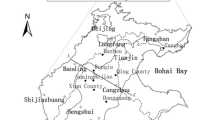Abstract
Land subsidence in China occurs predominantly in 17 provinces (cities) situated in the eastern and middle regions of the country, including Shanghai, Tianjin and Jiangsu, and Hebei provinces. It is primarily caused by groundwater overpumping. One of the areas most severely affected by land subsidence is the Yangtze Delta, most of which consists of Shanghai City, the Su-Xi-Chang area (Suzhou, Wuxi and Changzhou cities) of Jiangsu Province, and the Hang-Jia-Hu area (Hangzhou, Jiaxing and Huzhou cities) of Zhejiang Province. The excessive exploitation of groundwater forms in a large regional cone of depression and, consequently, land subsidence is also regional, currently centered in the Shanghai and Su-Xi-Chang areas. In 2002, the maximum cumulative subsidence of Shanghai, Su-Xi-Chang and Hang-Jia-Hu were 2.63 m, 2.00 and 1.06 m, respectively. The land subsidence area is continuing to expand throughout the Yangtze Delta. To study the characteristics and the pattern of this land subsidence, the government has implemented a monitoring system involving the placement of 37 groups of extensometers (layers marks) and drilling of more than 1000 observation wells. These provide an invaluable historical record of deformation and pore water pressure and facilitate studies on the special features of soil deformation when the groundwater level changes due to pumping. Several measures have been taken in recent years to control the development of the land subsidence in the different areas; these include groundwater injection, prohibition of pumping deep confined groundwater, and an adjustment of the pumping depth and magnitude of the groundwater withdrawn. At present, although the subsidence area is still increasing slowly, the subsidence rate is controlled.











Similar content being viewed by others
References
Gambolati G, Freeze RA (1973) Mathematical simulation of the subsidence of Venice: 1.Theory. Water Resour Res 9:721–733
Gambolati G, Gatto P, Freeze RA (1974) Mathematical simulation of the subsidence of Venice: 2. Results. Water Resour Res 10:563–577
Helm DC (1975) One-dimensional simulation of aquifer system compaction near Pixley, California: (1) Constant parameters. Water Resour Res 11:198–12
Helm DC (1976) One-dimensional simulation of aquifer system compaction near Pixley, California: (2) Stress-dependent parameters. Water Resour Res 12:121–30
Leake SA (1990) Interbed storage changes and compaction in models of regional groundwater flow. Water Resour Res 26:1939–1950
LEHGGS (Laboratory of Engineering and Hydrological Geology and Geophysical Survey, Liege university, Belgium, Institute of geological survey of Belgium) and GCSER (Geological Center of Shanghai Economic Region) (1989). Study on the Quaternary geology, hydrogeology, engineering geology and mathematical model of land subsidence of Yangtze Delta of Shanghai (in Chinese). LEHGGS/GCSER, Liege/Shanghai
Li QF, Fang Z, Wang HM (2000) Calculation and prediction of model of extractive groundwater in Shanghai (in Chinese). Shanghai Geology 13:36–43
NCCGS (Nanjing Center, China Geological Survey), Geological Survey of Jiangsu Province, SIGS (Geological Survey of Shanghai), Geological Survey of Zhejiang Province (2003) Investigation and estimation on groundwater resources and geological disasters on Yangtze Delta (in Chinese)
Poland GF, Davis GH (1969) Land subsidence due to the withdrawal of fluids. Rev Eng Geol 2
Pratt WE, Johnson DW (1926) Local subsidence of the Goose Creek oil field. J Geol 34:577–590
Shi XQ, Xue YQ, Wu JC et al (2006) Study on soil deformation properties of groundwater system in Changzhou area (in Chinese). Hydrogeol Eng Geol 33:1–6
Shi XQ, Xue YQ, Ye SJ et al (2007a) Characterization of land subsidence induced by groundwater withdrawals in Su-Xi-Chang area, China. Environ Geol 52:27–40
Shi XQ, Xue YQ, Wu JC, et al. (2007b) Land subsidence simulation in Su-Xi-Chang area and Shanghai City. Water–Rock Interaction. In: Bullen TD, Wang Y (eds) Proc 12th Int Symp Water–Rock Interaction, vol 2. Taylor & Francis Group, London, pp 1403–1406
Sneed M, Galloway DL (2000) Aquifer-system compaction and land subsidence: measurements, analyses, and simulations-the Holly Site, Edwards Air Force Base, Antelope Valley, California. U.S. Geological Survey Water–Resources Investigations Report 00–4015
Sun WS (2002) Investigation report on prevention and control of land subsidence in Yangtze Delta (in Chinese). In: Wei ZX, Li QF (eds) Proc Natl Symp Land subsidence, Shanghai Institute of Geology Survey, Shanghai, pp 1–12
USGS (1999) Land subsidence in the United States. In: Galloway D, Jones D, Ingebritsen SE (eds) Circular 1182. ASCE, New York, p 177
Wei ZX (2002) Stress and strain analysis of the fourth artesian aquifer in Shanghai (in Chinese). Hydrol Eng Geol 29:1–4
Wei ZX, Yang GF, Yu JY (2005) Stress-strain characteristics of the confined aquifer system and land subsidence controlling countermeasures in Shanghai (in Chinese). Chin J Geol Hazard Control 16:5–8
Xue YQ, Zhang Y, Ye SJ et al. (2005) Land subsidence in China. Enviorn Geol 48:713–720
Ye SJ, Xue YQ, Zhang Y et al. (2005), Study on the ground water flow model for land subsidence modeling in Shanghai. In Zhang Agen et al. (eds) Land subsidence. Proc 7th Int Symp Land Subsidence, pp 628–634
Yu J, Wu JQ, Wang XM, Yu Q (2004) Research on the correlative prediction model with a regional decomposition base of the land subsidence in the Suzhou-Wuxi-Changzhou area (in Chinese). Hydrogeol Eng Geol 4:92–95
Yu J, Wang XM, Wu JQ, Xie JB (2006) Characteristics of land subsidence and its remedial proposal in Suzhou-Wuxi-Changzhou area (in Chinese). Geol J China Univ 12:179–184
Zhang AG, Wei ZX (eds) (2005) Land subsidence in China (in Chinese). Shanghai Scientific & Technical Publishers, Shanghai
Zhu XB, Wu JC, Ye SJ et al (2004) Groundwater modeling for deep aquifers in the Yangtze Delta (south of the Yangtze River). Geochim Cosmochim Acta 68[Suppl]:A175–A175
Acknowledgments
The author would like to express appreciation to the two anonymous reviewers for their valuable comments and suggestions. This paper is financially supported by the National Nature Science Foundation of China grants No. 40335045, 40672160 and the National Science Foundation for Distinguished Youth Scholar No. 40725010.
Author information
Authors and Affiliations
Corresponding author
Rights and permissions
About this article
Cite this article
Wu, J., Shi, X., Xue, Y. et al. The development and control of the land subsidence in the Yangtze Delta, China. Environ Geol 55, 1725–1735 (2008). https://doi.org/10.1007/s00254-007-1123-x
Received:
Accepted:
Published:
Issue Date:
DOI: https://doi.org/10.1007/s00254-007-1123-x




